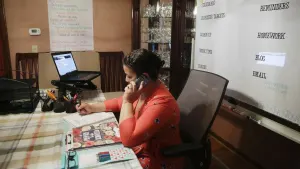More Stories
The National Association of Theater Owners is helping to take the guess work out of safe operating practices for movie theaters in the era of COVID-19.
The trade organization announced a set of health and safety protocols based on research and guidelines from the Centers for Disease Control and Prevention, the World Health Organization and the Occupational Safety and Heath Administration. Over 300 companies representing more than 2,600 theater locations in the U.S. have already signed on to the CinemaSafe program.
Below are 11 guidelines for health and safety developed by the association:
Below are 11 guidelines for health and safety developed by the association:
1. Masks required:
All employees must wear a face covering or mask. Patrons must wear a face covering at all times, except as noted by the CDC and herein. Those who are unwilling to wear a face covering will be denied entry.
All employees must wear a face covering or mask. Patrons must wear a face covering at all times, except as noted by the CDC and herein. Those who are unwilling to wear a face covering will be denied entry.
2. Social distancing:
Appropriate physical distancing must be maintained at all times between patrons, except members of the same household or those that attend together.
Appropriate physical distancing must be maintained at all times between patrons, except members of the same household or those that attend together.
3. Reduced capacity:
Theaters will explore novel options to minimize the number of patrons in an auditorium.
Theaters will explore novel options to minimize the number of patrons in an auditorium.
4. Air filtration:
All HVAC systems should be in working order with increased ventilation whenever possible.
All HVAC systems should be in working order with increased ventilation whenever possible.
5. Frequent hand-washing:
Employees should be trained on hand-hygiene practices, and are required to wash hands frequently at easily-accessible hand-washing facilities.
Employees should be trained on hand-hygiene practices, and are required to wash hands frequently at easily-accessible hand-washing facilities.
6. Hand sanitizer:
Hand sanitizer with at least 60% alcohol (EPA approved ethanol or isopropyl) will be liberally placed in easily accessible public areas and patrons will be encouraged by staff and appropriately placed signage to practice hand hygiene.
Hand sanitizer with at least 60% alcohol (EPA approved ethanol or isopropyl) will be liberally placed in easily accessible public areas and patrons will be encouraged by staff and appropriately placed signage to practice hand hygiene.
7. Enhanced cleaning:
Auditoriums should be carefully disinfected between movie screenings. High-touch surfaces should be wiped down periodically with EPA-registered disinfectant.
Auditoriums should be carefully disinfected between movie screenings. High-touch surfaces should be wiped down periodically with EPA-registered disinfectant.
8. Employee health training:
All employees should be trained on the signs and symptoms of COVID-19 as well as local theatre policies and procedures.
All employees should be trained on the signs and symptoms of COVID-19 as well as local theatre policies and procedures.
9. Modified concessions:
Minimize cash transactions and encourage credit cards or contactless payments whenever possible. Theaters will eliminate communal food and condiments that requires shared serving utensils or equipment.
Minimize cash transactions and encourage credit cards or contactless payments whenever possible. Theaters will eliminate communal food and condiments that requires shared serving utensils or equipment.
10. Mobile ticketing:
Tickets sales should be available online or via phone whenever feasible to reduce the need to stand in line for tickets. Alternatives to paper tickets should be used whenever possible.
Tickets sales should be available online or via phone whenever feasible to reduce the need to stand in line for tickets. Alternatives to paper tickets should be used whenever possible.
11. Not feeling well? Stay home:
If you are experiencing a fever, cough, shortness of breath, loss of taste or smell, or other symptoms that could be related to COVID-19, please stay home and we welcome you to join us again in the future.
If you are experiencing a fever, cough, shortness of breath, loss of taste or smell, or other symptoms that could be related to COVID-19, please stay home and we welcome you to join us again in the future.
Most indoor movie theaters shuttered in mid-March to help prevent the spread of coronavirus. Last week, the major theater chains in the U.S. started to slowly reopen locations. Although many have said they are complying with local mandates and generally accepted best practices, there was not until now a set of industry-wide guidelines. This lack of oversight led to situations like the mask backlash that resulted in all the major exhibitors reversing course to require face coverings.
The CinemaSafe protocols are voluntary. Companies complying with the guidelines can display a CinemaSafe badge on their websites and, eventually, at their locations so patrons are aware. See the bottom of this page for the list of companies that have committed to meet or exceed the CinemaSafe protocols.
Dr. David F. Goldsmith, an occupational and environmental epidemiologist at George Washington University’s Milken Institute School of Public Health, reviewed the CinemaSafe guidelines.
“These protocols, and the way they were developed, demonstrate a serious, comprehensive effort by movie theater owners to examine every aspect of their operations, identify potential risks, and reduce them," Goldsmith said.
Dr. Joyce Sanchez, an infectious disease specialist and director of the Travel Health Clinic at Froedtert & the Medical College of Wisconsin, said that the protocols address, “Two of the three general concepts that factor into activity risk: distance, dose and duration.”
Sanchez said that duration can’t be controlled but noted that movie runtimes are similar to that of a domestic flight or time spent at a restaurant.
“While every activity outside the home carries risks, these additional measures can help to mitigate them,” she added.
The CinemaSafe protocols are voluntary. Companies complying with the guidelines can display a CinemaSafe badge on their websites and, eventually, at their locations so patrons are aware. See the bottom of this page for the list of companies that have committed to meet or exceed the CinemaSafe protocols.
Dr. David F. Goldsmith, an occupational and environmental epidemiologist at George Washington University’s Milken Institute School of Public Health, reviewed the CinemaSafe guidelines.
“These protocols, and the way they were developed, demonstrate a serious, comprehensive effort by movie theater owners to examine every aspect of their operations, identify potential risks, and reduce them," Goldsmith said.
Dr. Joyce Sanchez, an infectious disease specialist and director of the Travel Health Clinic at Froedtert & the Medical College of Wisconsin, said that the protocols address, “Two of the three general concepts that factor into activity risk: distance, dose and duration.”
Sanchez said that duration can’t be controlled but noted that movie runtimes are similar to that of a domestic flight or time spent at a restaurant.
“While every activity outside the home carries risks, these additional measures can help to mitigate them,” she added.
A report from AP film writer Lindsey Bahar contributed to this list.
More from News 12

Your Coronavirus 2020 Photos

10 online learning tools for students to use at home
11:21:40

6 tips for home schooling children and remote learning

7 online remote learning tools for educators
8:38:20

17 tips for students, parents and teachers using video in virtual classes
12:24:27
